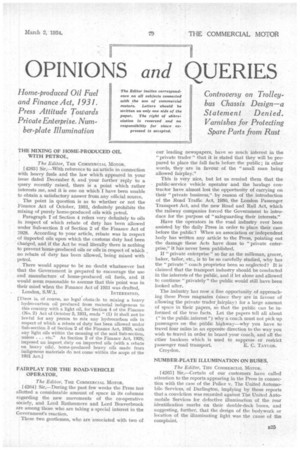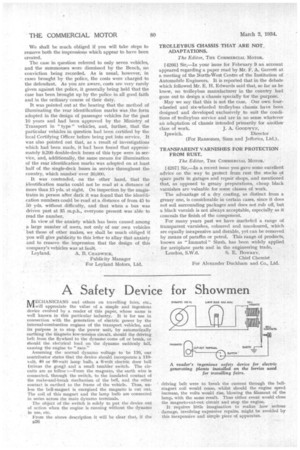OPINIONS and QUERIES
Page 39

Page 40

If you've noticed an error in this article please click here to report it so we can fix it.
THE MIXING OF HOME-PRODUCED OIL WITH PETROL.
The Editor, THE COMMERCIAL MOTOR.
[42631 Sir,—With reference to an article in connection with heavy fuels and the law which appeared in your issue dated December 8, and your further reply to a query recently raised, there is a point which rather interests me, and it is one on which I have been unable to obtain a satisfactory answer from any official source.
The point in question is as to whether or not the Finance Act of October, 1931, definitely prohibits the mixing of purely home-produced oils with petrol.
Paragraph t of Section 4 refers very definitely to oils in respect of which rebate of duty has been allowed under Sub-section 3 of Section 2 of the Finance Act of 1928. According to your article, rebate was in respect of imported oils upon which the customs duty had been charged, and if the Act be read literally there is nothing to prevent home-produced oils or oils in respect of which no rebate of duty has been allowed, being mixed with petrol.
There would appear to be no doubt whatsoever but that the Government is prepared to encourage the use and manufacture of home-produced oil fuels, and it would seem reasonable to assume that this point was in their mind when the Finance Act of 1931 was drafted.
London, S.W.1. INTERESTED.
[There is, of course, no legal obsta7le to mixing a heavy hydro-carbon oil produced from material indigenous to this country with a light oil, for Section 4 of the Finance (No. 2) Act of October 5, 1931, reads (I) It shall not be lawful for any person to mix any hydrocarbon oils in respect of which a rebate of duty has been allowed und.?,r Sub-section•S of Section 2 of the Finance Act, 1928, with any light oils within the meaning of the said Sub-section, unless . . . etc." As Section 2 of the Finance Act, 1928, imposed an import duty on imported oils (with a rebate on heavy oils), home-produced heavy oils made from indigenous materials do not come within the scope of the 1931 Act.]
FAIRPLAY FOR THE ROAD-VEHICLE OPERATOR.
The Editor, THE COMMERCIAL MOTOR.
[4264] Sir,—During the past few weeks the Press has allotted a considerable amount of space in its columns regarding the new movements of the co-operative society, and Lord Rothermere and Lord Beaverbrook are among those who are taking a special interest in the Government's reaction.
These two gentlemen, who are associated with two of our leading newspapers, have so much interest in the "private trader" that it is stated that they will be prepared to place the full facts before the public ; in other words, they are in favour of the "small man being allowed fairplay."
This is very nice, but let us remind them that the public-service vehicle operator and the haulage contractor have almost lost the opportunity of carrying on their "private business,". by reason of the introduction of the Road Traffic Act, 1930, the London Passenger Transport Act, and the new Road and Rail Act, which the railway companies forced the Government to introduce for the purpose of "safeguarding their interests."
Have the operators in the road industry ever been assisted by the daily Press in order to place their case before the public? When an association or independent body has written any article to the Press, pointing out the damage these Acts have done to "private enterprise," it has never been published.
If "private enterprise" so far as the milkman, grocer, baker, tailor, etc., is to be so carefully studied, why has the " private " coach proprietor been so neglected? It is claimed that the transport industry should be conducted in the interests of the public, and if let alone and allowed to continue " privately" the public would still have been looked after.
The industry has now a fine opportunity of approaching these Press magnates (since they are in favour of allowing the private trader.fairplay) for a large amount of space in their papers, so that the public can be informed of the true facts. Let the papers tell all about (" in the public interest ") why a coach must not pick up passengers on the public highway—why you have to travel four miles in an opposite direction to the way you wish to travel in order to board your coach, and all the ether bunkum which is used to suppress or restrict
passenger road transport, E. C. TAYLOR. Croydon.
NUMBER-PLATE ILLUMINATION ON BUSES.
The Editor, THE COMMERCIAL MOTOR.
[4265] Sir,—Certain of our customers have called attention to the reports appearing in the Press in connection with the case of the Police v. The United Automobile Services, of Darlington, implying by those reports that a conviction was recorded against The United Automobile Services for defective illumination of the rear identification marks on their double-deck buses, and suggesting, further, that the design of the bodywork or location of the illuminating light was the cause of the complaint.
We shall be much obliged if you will take steps to remove both the impressions which appear to have been created.
The case in question referred to only seven vehicles, and the summonses were dismissed by the Bench, no conviction being recorded. As is usual, however, in cases brought by the police, the costs were charged to the defendant. As you are aware, costs are very rarely given against the police, it generally being held that the case has been brought up by the police in all good faith and in the ordinary course of their duty.
It was pointed out at the hearing that the method of illuminating.the rear identification marks was the form adopted in the design of passenger vehicles for the past 10 years and had been approved •by the Ministry of Transport in " type " vehicles, and, further, that the particular vehicles in question had been certified by the local Certifying Officer before being put into service. It was also pointed out that, as a result of investigations which had been made, it had been found that approximately 9,200 double-deck buses of this type were in service, and, additionally, the same means for illumination of the rear identification marks was adopted on at least half of the single-deck buses in service throughout the country, which number over 30,000.
It was contended, on the other hand, that the
identification marks could not be read at a distance of more than .15 yds. at night. On inspection by the magistrates in person after dark it was found that the identification numbers could be read at a distance of from 45 to 50 yds. without difficulty, and that when a bus was driven past at 35 m.p.h., everyone present was able to read the number.
In view of the anxiety which has been caused among a large number of users, not only of our own vehicles but those of other makes, we shall be much obliged if. you will give publicity to this letter to allay that anxiety and to remove the 'impression that the design of this company's vehicles was at fault.
Leyland, A. B. CHADWICK,
Publicity Manager For Leyland Motors, Ltd. TROLLEYBUS CHASSIS THAT ARE NOT, ADAPTATIONS.
The Editor, THE COMMERCIAL MOTOR,
14266] Sir,—In your issue for February 9 an account appeared regarding a paper read by Mr. F. A. Garrett at a meeting of the North-West Centre of the Institution of Automobile Engineers. It is reported that in the debate which followed Mr. E. H. Edwards said that, so far as he knew, no trolleybus manufacturer in the country had gone out to design a chassis specially for the purpose. • May we say that this is not the case. Our own fourwheeled and six-wheeled trolleybus chassis have been designed and developed exclusively to suit the conditions of trolleybus service and are in no sense whatever an adaptation of chassis intended primarily for another
class of work. J. A. GOODWYN,
Ipswich. Director (For Ransomes, Sims and Jefferies, Ltd.).
TRANSPARENT VARNISHES FOR PROTECTION FROM RUST.
The Editor, THE COMMERCIAL MOTOR.'
14267] Sir,—In a recent issue you.gave some excellent advice on the way to protect from rust the stocks of spare parts in garages and repair shops, and mentioned that, as opposed to greasy preparations, cheap black varnishes are valuable for some classes of work.
The advantage of a dry coating, as distinct from a greasy one, is considerable in certain cases, since it does not soil surrounding packages and does not rub off, but a black varnish is not always acceptable, especially as it conceals the finish of the component.
For many years past we have marketed a range of transparent varnishes, coloured and uncoloured, which are equally inexpensive and durable, yet can be removed by means of paraffin or petrol. This range of products, known as "Immutol " Slush, has been widely applied for aeroplane parts and in the engineering trade.
London, S.W.fl. S. E. BOVVREY,
Chief Chemist For Alexander Duckham and Co., Ltd.




























































































